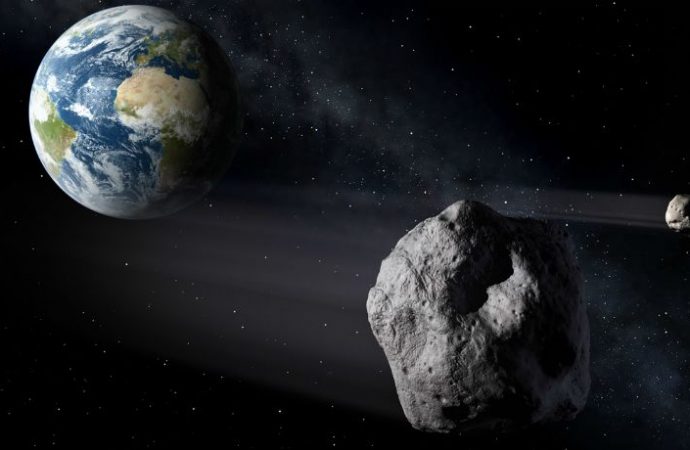While two of these space rocks are not coming back any time soon, the other two hit their closest approach to Earth for a long while to come.
Source: Inquisitor
In a series of close asteroid encounters, Earth was visited by four different space rocks over the course of Friday, April 12. While three of these asteroids were not particularly imposing space rocks, measuring no more than a couple of hundred feet across, one of yesterday’s celestial visitors boasted a much fuller diameter and was estimated to be around 460 feet wide.
According to asteroid trackers at NASA’s Center for Near-Earth Object Studies (CNEOS), the first space rock to zip past Earth in the early hours of the morning was a 236-foot asteroid dubbed 2019 FB3. As its denomination suggests, this particular celestial body was discovered this year, with its first sighting occurring on March 31. After analyzing its orbit and trajectory for the past 11 days, scientists as NASA’s Jet Propulsion Laboratory (JPL) in Pasadena, California, were able to calculate the date of its close approach, as well as its cruising speed through the cosmos.
Data released earlier on Friday by the JPL showed that asteroid 2019 FB3 performed a close flyby of Earth at 3:58 a.m. ET, coming within 2.8 million miles of our planet. That’s about 11.83 times the distance between Earth and the moon. During the moment of its close approach to Earth, the asteroid hurtled past our home world at a breakneck speed of nearly 31,700 mph, or 41.3 times the speed of sound — traveling through space slightly faster than two of its successors.
While this wasn’t Earth’s last brush with 2019 FB3, the asteroid won’t be back for nearly a century. The space rock will double back for a return visit 89 years from now, on April 23, 2108. After that, it will disappear for another 88 years, only to pop back on September 7, 2197. However, none of the upcoming flybys will be as close as yesterday’s encounter.

Shortly after the brush with 2019 FB3, another space rock zoomed past Earth in the pre-dawn hours of Friday morning. Known as 2019 GC4, the space rock hurtled past our planet a few minutes after its predecessor, passing within 1.2 million miles of Earth at 4:11 a.m. ET. This means that, during its close approach to Earth, the asteroid was 5.11 times more distant than the moon.
First spotted a little more than a week ago, on April 4, asteroid 2019 GC4 was estimated to measure between 91.8 feet and 203.4 feet across, notes the JPL. This makes it slightly smaller than 2019 FB3, which is thought to have a diameter ranging between 104.9 feet and 236.2 feet.
Barreling through space at phenomenal speeds of a little over 75,000 mph, asteroid 2019 GC4 was more than twice as fast as its predecessor. The space rock will not be making a return trip to our corner of the solar system for the foreseeable future.

A few hours later, asteroid 2019 GL4 buzzed Earth just in time for the morning coffee. The remarkable thing about this particular space rock is that it’s the largest of the four celestial visitors to pass by our planet yesterday. Estimated to be between 206.6 feet and 459.3 feet wide, 2019 GL4 darted past Earth at 7:43 a.m. ET. According to the JPL, the space rock came within 3.4 million miles of the planet’s surface – or 14.40 times the lunar distance.
The last time that asteroid 2019 GL4 came swinging by our corner of the cosmic woods was seven years ago, on April 29, 2012. At the time, the space rock only managed to approach within 32.7 million miles of Earth. Asteroid 2019 GL4 is not likely to return any time soon.
Last but not least, the final close encounter of the day was with asteroid 2019 GQ1. Thought to measure between 98.4 feet and 216.5 feet across, the space rock came whizzing past Earth at 9:11 a.m. ET, flying past our planet at a distance of 3.1 million miles.
As the JPL points out, the asteroid will return later this year for another close flyby on October 5. However, during its upcoming approach, the space rock will only come within 26.2 million miles of Earth. The last time that asteroid 2019 GQ1 paid Earth a visit was six decades ago, on March 24, 1959. Its previous flyby was an even more distant one, bringing the asteroid just within 42.8 million miles of our planet.
On April 13, Earth will be visited by another batch of five asteroids, as previously reported by The Inquisitr.

































Leave a Comment
You must be logged in to post a comment.